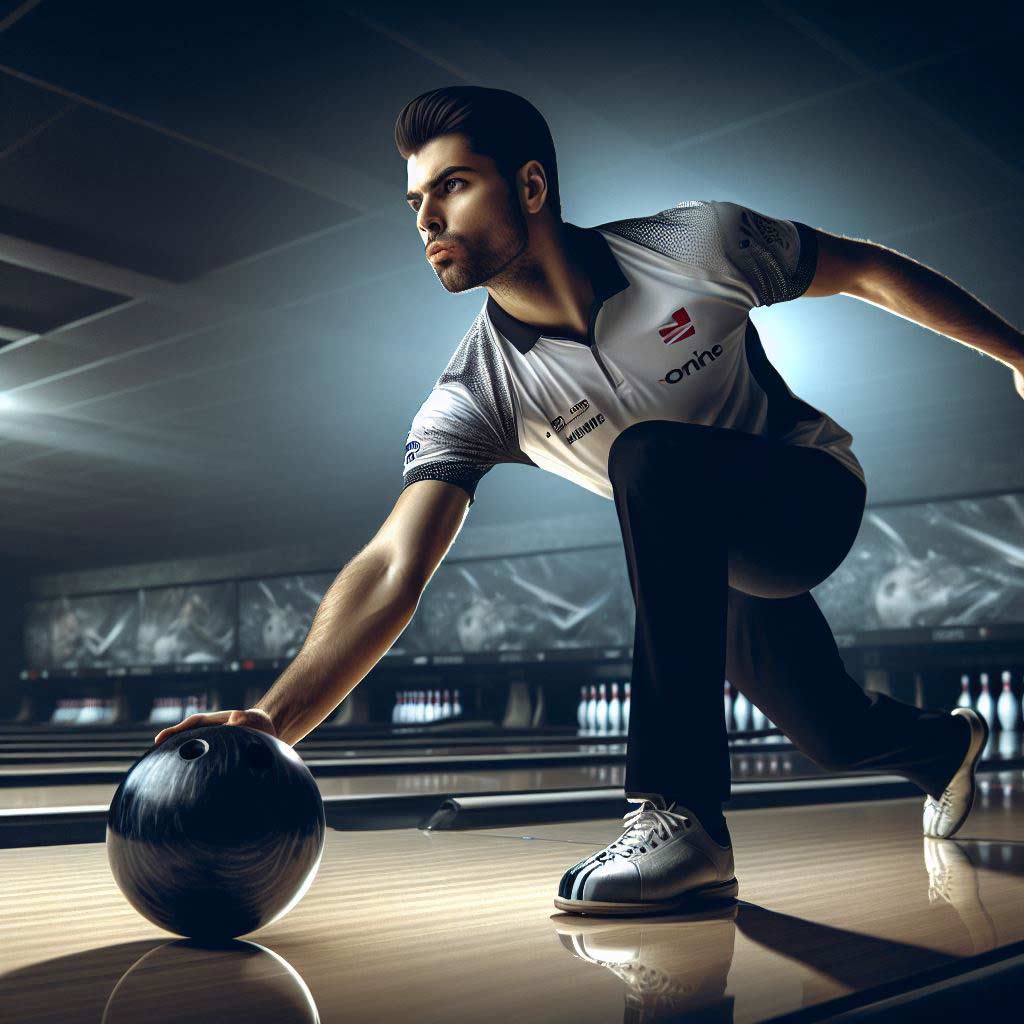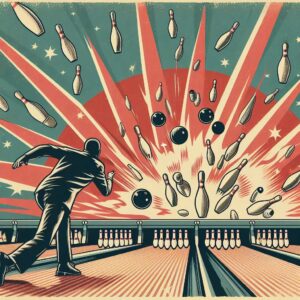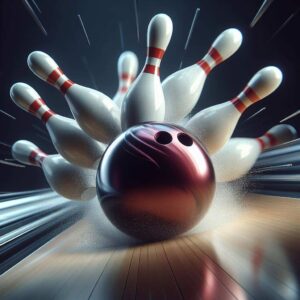Bowling is one of America’s most popular pastimes, with over 70 million people heading to the lanes every year.
Yet despite its widespread appeal and competitive nature, bowling is often not considered a “real” sport by many athletes and fans.
For years, pro bowlers have had to contend with the perception that bowling is nothing more than a recreational activity suited for beer-swilling amateurs.
But many in the bowling world insist their sport requires just as much skill and prowess as any other professional athletic competition.
So does bowling deserve to sit alongside venerable sports like football, baseball, and basketball? Or is it merely a game, devoid of the physicality and competitiveness required of true athletic pursuits?
In this article, we’ll take an objective look at the criteria that define a sport and settle the “Is bowling a sport” debate once and for all.
The Definition of Sport
Before evaluating bowling’s credentials, let’s establish a clear definition of what constitutes a sport.
According to dictionary definitions, a sport is a physical activity involving skill and competition. More specifically, some key elements that typically make up a sport are:
- Athletic prowess involves physical exertion, skill, and dexterity. Sports require varying degrees of fitness, strength, speed, and precision.
- Formalized rules that standardize how the sport is played and judged.
- Competitive formats that allow athletes or teams to compete head-to-head under standardized conditions. Sports have set ways to determine winners and losers.
- Governing organizations that set rules, organize competitions, maintain rankings, and select players for teams. Most major sports have national/international federations.
- Subcultures of fans and athletes devoted to the sport. Sports attract dedicated participants, spectators, communities, media coverage, etc.
Many major athletic organizations like the Olympics and ESPN recognize bowling as a legitimate competitive sport based on these criteria.
However, some critics claim bowling falls short in key areas like physicality. Let’s examine the case for bowling’s athletic merits.
The Physical Side of Bowling
At first glance, bowling may not seem like the most strenuous activity. However, a deeper look reveals that bowling requires considerable physical dexterity, skills, strength, and stamina. Here are some of bowling’s athletic credentials:
- Repetitive lifting and throwing: The bowling ball weighs up to 16 pounds. Bowlers repetitively lift and control this weight to throw balls at up to 20 mph for hours. This takes considerable upper body, finger, and core strength.
- Specific muscle group usage: Bowling utilizes specific muscle groups not prominently used in other sports, particularly the fingers, wrist, forearm, and back muscles. Proper technique requires flexing muscles in precise ways.
- Importance of physical consistency: Achieving a uniform bowling form and release requires finely tuned muscle memory. This level of repetitive physical precision is difficult to maintain for long periods.
- Balance, control, and fluidity of motion: A smooth, athletic bowling approach requires balance, footwork, weight shift, and fluid motion. These aspects of body control are similar to the mechanics involved in sports like golf or pitching.
- Physical impact through legs and knees: The bowling release requires bending knees and exerting force through the legs to generate speed and power. This taxes the legs throughout multiple games.
Bowling involves extensive use of specialized muscle groups, balance, intricate hand-eye-foot coordination, and athletic motions.
While it does not emphasize cardiovascular endurance like sports such as basketball, the technical physical abilities required deserve acknowledgment.
Bowling as Competition
All sports are built around competitive formats that judge success by wins and losses. Bowling has all the hallmarks of a fiercely competitive sport:
- Standardized rules and scoring: Bowling has a universally standardized scoring system and criteria to judge winners. This creates a fair competitive environment, like any sport.
- Leagues and tournaments: There are numerous bowling leagues and tournaments at local, regional, national, and international levels. These feature head-to-head competitions and big prizes on the line.
- Major competitive events: Competitions like the USBC Open Championships and U.S. Women’s Open attract top bowlers vying for glory and large payouts, much like major golf or tennis tournaments.
- Rankings and qualifying mechanisms: Bowling has official ranking systems, based on averages and earnings, that determine qualification/seeding for major tournaments. This structured pathway of advancement emulates the competitive formats in many sports.
- Championship titles and trophies: Winning major bowling events brings recognition as the best of the best, along with prestigious titles and coveted trophies. Every sport has its pinnacle achievements.
- Team competitions: Bowling features many team-based leagues and tournaments. Teams compete to win titles and banners, fostering fierce rivalries reminiscent of pro-team sports.
With its standardized competitive system, bowlers compete for wins, ranking, championships, and money. Bowling undoubtedly fulfills the competitive aspect that lies at the heart of sports.
Elite Bowlers Display Athleticism
Critics of bowling as a sport claim it lacks athleticism. But professional bowlers demonstrate immense skill, precision, competitiveness, and physical stamina – the hallmarks of elite athletes.
Consider a few examples:
- Jason Belmonte: This Australian star has been called the “LeBron James” of bowling for his power and competitiveness. He has invented unique bowling techniques and is considered the greatest bowler ever.
- Pete Weber: One of bowling’s biggest personalities, Weber has won a record 37 PBA titles. He’s known for his intensity, competitiveness, and emotional outbursts reminiscent of star athletes in other sports.
- Liz Johnson: This top female bowler has won over 20 professional tournaments, displaying world-class consistency and poise under pressure. She’s widely considered the best women’s bowler in history.
- Norm Duke: At 5’5” and 130 pounds, Duke doesn’t look like a world-class athlete. But he’s won over 40 pro tournaments thanks to his dedication, strategic mastery, and flawless technique that allows him to bowl alongside much bigger men.
- Tom Daugherty: This bowler rolled a perfect 900 series in competition, the epitome of physical precision. Less than 50 perfect games have ever been bowled.
- Kelly Kulick: She was the first woman ever to win a PBA men’s tournament, beating out elite male bowlers with her superior skill. This historic achievement demonstrated women can compete athletically with men.
The technical mastery, mental fortitude, and physical consistency exhibited by elite bowlers demonstrate bowling truly requires an athletic skillset.
Bowling’s Culture and Community
Sports are defined not just by competition, but by the passions and communities they inspire. The culture surrounding bowling bears many similarities to “major” sports.
- Subcultures: Like video games or skateboarding, bowling enjoys fierce devotion among niche subcultures who live the “bowling lifestyle”. These superfans get bowling-themed tattoos, furniture, apparel, and more.
- Lifelong dedication: Many bowlers devote their lives to the sport, practicing countless hours to hone techniques. Such single-minded devotion mirrors the dedication of athletes in any sport.
- Competitive drive: Bowlers exhibit an intense desire to win and achieve bowling greatness. The will to prevail pushes bowlers to train tirelessly to gain an edge, like athletes in any competitive arena.
- Mental game: Bowling psychology, focus, and composure are determining factors in top performance. Elite bowlers leverage mental skills and fortitude just like other athletes under pressure.
- Trash talking and rivalries: Competitive bowling breeds the same rivalries and bravado found in many major sports. Bowlers are known for trash talk, bold gestures, and rivalries that fuel their competitive fire.
- Specialized media: Bowling has dedicated sports networks, publications, fantasy leagues, video games, and more. The community surrounding bowling mirrors other established sports.
The passion and competitive spirit within bowling communities worldwide show that bowling elicits the same cultural identity and devotion associated with recognized sports.
Conclusion: Bowling Undeniably Qualifies as a Sport
After dissecting the athleticism, competitiveness, skill, and culture underlying bowling, we can definitively conclude that bowling deserves classification as a legitimate sport.
Bowling meets all the criteria that define a sport: specialized physical skills and dexterity, established rules and competitive formats, organizations and events, displays of athletic prowess, and a dedicated subculture.
Arguments against bowling as a sport tend to lack understanding of its intricacies and conflate the recreational side of bowling with its competitive realm.
But at the elite levels, bowling unquestionably demands athletes demonstrate the same physical mastery, competitive drive, and mental acuity required in any other sport.
Bowling lacks the mainstream recognition and following showered on major sports. But its low visibility relative to other sports has no bearing on whether bowling does or does not qualify as a sport under objective criteria. By any impartial assessment, bowling checks all the boxes that categorize an activity as a sport.
Of course, reasonable people can disagree on bowling’s degree of physicality relative to cardiovascular-intensive sports.
But no athlete would call golf, archery, shooting, or billiards physically demanding sports. Yet all are still recognized as sports for their skill-based athletic and competitive elements.
Like those sports, bowling also deserves its rightful classification as a sport based on the same merits.
So next time you hear someone say bowling isn’t a real sport, you can set the record straight on bowling’s merits.
Bowlers everywhere should feel confident embracing bowling’s identity as a legitimate, competitive sport with all the skill, passion, and community as any sport played around the world.
Bowling has unquestionably earned its place in the pantheon of revered athletic pursuits we call sports.
Frequently Asked Questions
Is bowling a sport or not?
Bowling is a sport based on its competitive formats, required physical skills and athleticism, governing organizations, and passionate community/culture surrounding it.
Is bowling recognized as a sport?
Yes, bowling is recognized as a sport by major sports governing bodies including the International Olympic Committee, ESPN X Games, USBC, and more. It fulfills all the standard criteria that define a competitive sport.
Is bowls a sport or a game?
Bowls, referring to lawn bowls or ten-pin bowling, are considered sports for the same reasons regular bowling is. They require physical skills and technique, have standardized rules for competition, and contain all the hallmarks of an athletic sport.
Is bowling a sport or a skill?
Bowling is both a sport and a skill. The technical skill required is a key part of what makes it a sport. The specialized physical abilities and mastery involved in bowling are comparable to skills required in many other sports.
Why do people say bowling isn’t a sport?
Some argue bowling isn’t a sport because it doesn’t involve as much cardiovascular exertion as sports like basketball. But skill-based sports like golf and archery don’t either. A lack of knowledge about bowling’s competitive side also fuels this misconception.
What sport is not a sport?
No major, officially recognized sports fail to meet the definition and criteria to be considered actual sports. Even less intense activities like golf and sharp shooting qualify as sports.
What is the oldest sport?
Wrestling and long jump are among the oldest sports, dating back over 7,000 years. Bowling also has ancient roots as an established sport going back to ancient Egypt and the Roman Empire over 3,000 years ago.
Is bowling a sport or a hobby?
Bowling can be both a casual hobby for recreational players and a serious competitive sport for professional and league players. The competitive side qualifies it as a sport based on the intensity, skill, and culture.
How big of a sport is bowling?
Bowling is a major sport worldwide with over 100 million participants. Prominent bowling organizations, competitions, champions, and devoted fans make bowling a sizable sport with an influential global footprint.





